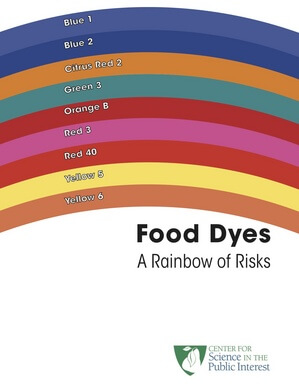
Americans are now eating five times as much food dye as we did in 1955. That statistic isn’t as surprising when you consider that since then food dyes have made more and more of our foods colorful–from breakfast cereals to ice creams.
While natural colorants made from foods like beets are available, many manufacturers opt for synthetic dyes–which may have dangerous health consequences, particularly for children, according to a recent report from the Center for Science in the Public Interest.
This is why the nonprofit Washington, D.C.-based consumer-watchdog group has asked the U.S. Food and Drug Administration to ban them. Such man-made food dyes appear in ingredient lists as a name of a color with a number following it: Blue 1 and 2, Citrus Red 2, Green 3, Red 3 and 40, Yellow 5 and 6.
Click Here to Read the Full Report
to Read the Full Report
The three most widely used culprits–Yellow 5, Yellow 6 and Red 40–contain compounds, including benzidine and 4-aminobiphenyl, that research has linked with cancer.
Research has also associated food dyes with problems in children including allergies, hyperactivity, learning impairment, irritability and aggressiveness. A U.S. study published in Science found that when children who scored high on a scale measuring hyperactivity consumed a food-dye blend they performed worse on tests that measured their ability to recall images than when they drank a placebo.
A 2007 British study found that children who consumed a mixture of common synthetic dyes displayed hyperactive behavior within an hour of consumption. (These children had not been diagnosed with ADD or ADHD.) The results, published in The Lancet, prompted Britain’s Food Standards Agency to encourage manufacturers to find alternatives to food dyes.
In July 2010, the European Parliament’s mandate that foods and beverages containing food dyes must be labeled as such went into effect for the entire European Union.
Preliminary evidence suggests that many children have a slight sensitivity to food dyes–and a smaller percentage are very sensitive.
“We see reactions in sensitive individuals that include core ADHD symptoms, like difficulty sitting in a chair and interrupting conversations,” says David Schab, M.D., M.P.H., assistant clinical professor of psychiatry at Columbia University and co-author of a 2004 meta-analysis that found food dyes promote hyperactive behavior in already hyperactive children.
Even so, says Schab, this isn’t the most compelling reason to give up food dyes. “Foods with dyes are often riddled with other nutritional problems, like excess calories and fat,” says Schab, who points out that childhood obesity is a far greater public health concern.
Bottom Line: If you’re concerned, ditch the potentially dangerous synthetic dyes. Look for foods bearing the green-and-white USDA certified organic label, but be aware that foods labeled “made with organic ingredients” may still contain synthetic dyes. You can also check product ingredient lists for beet, carotenes, annatto, capsanthin (a paprika extract)–as all are natural colorants.
Counterintuitively, the terms “artificial color,” “artificial color added” or “color added” also indicate that nature-derived pigments were used since synthetic dyes must be listed by their names.
– Milton Stokes, M.P.H., R.D.
EatingWell is a magazine and website devoted to healthy eating as a way of life. Online at www.eatingwell.com.
(c) 2011 Eating Well, Inc. DISTRIBUTED BY TRIBUNE MEDIA SERVICES, INC.

